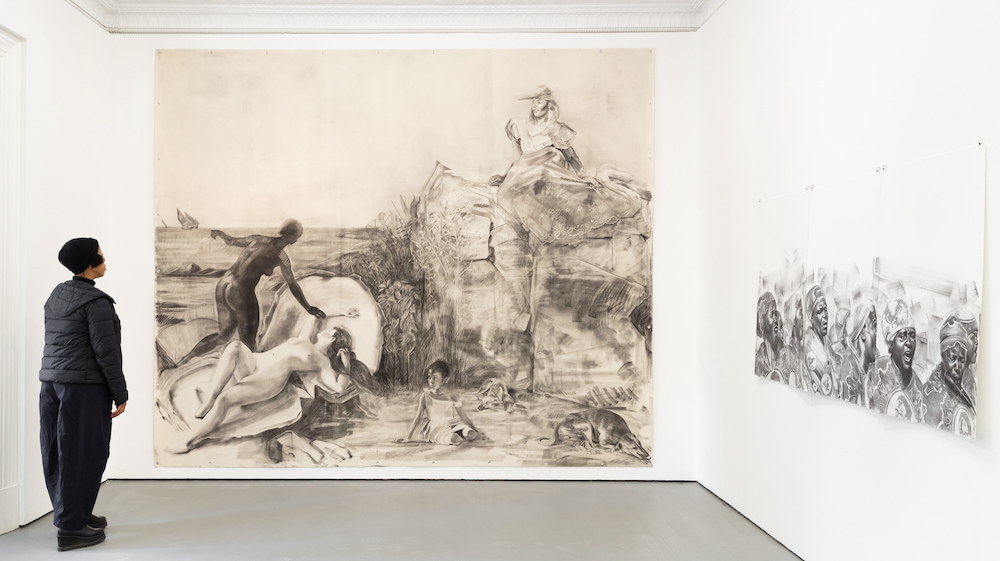Johannesburg
5 July - 22 August 2025Meleko Mokgosi
Speculations on Drawing

Meleko Mokgosi, Speculations on Drawing, 2025, installation view
STEVENSON is proud to present Appellations and Speculations on Drawing by Meleko Mokgosi, taking place across our Cape Town and Johannesburg spaces, jointly marking his third exhibition with the gallery.
Where Mokgosi’s previous exhibitions in these cities formed part of Democratic Intuition (2013-19), an eight-chapter project examining the ways in which democracy is conceptualised, constituted and experienced within southern Africa, the works in Appellations and Speculations on Drawing chiefly derive from Spaces of Subjection, his current multi-chapter tableau. The spaces explored in this body of work span the physical, discursive and otherworldly; his concept of subjection encompasses facets of self-making including subjectivity, subjecthood and subjugation. Referencing Michel Foucault’s theories, this series advances Mokgosi’s argument that ‘subjection is a structural necessity for becoming’.
The works in Speculations on Drawing span screenprints, etchings, chine collé, dry point, charcoal and digital drawing on three dimensional objects - all balancing line and space to examine drawing as process, concept, and a theoretical framework. The selected drawings act in tandem with the concerns of Mokgosi’s painting practice, interspersing art historical references with iconographic southern African motifs including domestic interiors, guard dog posters and modernist-inspired figurines. The artist’s configuration of images weaves an elliptical tableau on subjection, subjecthood and representation. He provides the following statement:
As a practice that conventionally concerns itself with the notion of the index, drawing seems to always centre the body. Regardless of the presence of the body in a drawing, the body is foundational to drawing because it is the body that the drawing process depends on, and the body is “an object the proposed spaces are projected to contain.”
The discourse of art has largely privileged the indexical sign in drawing, which has in turn become a key part in the value of drawing. The indexical sign, formally defined as a sign that foregrounds the phenomenological bond between the sign and that which produces the sign, has come to mean many things: immediacy, directness, touch, gesture, signature, etc.
“Drawing is the opening of form. This can be thought in two ways: opening in the sense of a beginning, departure, origin, dispatch, impetus, or sketching out, and opening in the sense of an availability or inherent capacity. According to the first sense, drawing evokes more the gesture of drawing than the traced figure. According to the second, it indicates the figure’s essential incompleteness, a non-closure or non-totalizing of form. In one way or another, the word drawing retains a dynamic, energetic, and incipient value that does not exist in words like painting, film, or cinema.” – Jean-Luc Nancy, The Pleasure of Drawing
Drawing is continually perceived as supplemental to other art forms: painting, sculpture, design etc. Or to put it otherwise, drawing as a conceptual tool is used by theorists and philosophers to examine the parergonal; that is, the view of drawing as always not-finished, or as something that is at the service of another iteration of art.
It can be argued that because of its material processes and indexicality, drawing constantly allows us access to the contingent. To speak of contingency is to refer to things that are not yet known, that which is yet-to-come - most of which make themselves known on their terms. The contingent as incalculable or unexpected or the unverifiable – is framed by and through the experiencing body and its psyche (the psycho-somatic field of relations).
Drawing is a spatial articulation of things. First and foremost, we can say that drawing always already involves the idea of a line. Line however is an arbitrary but necessary delineation of space.
"The relationship between drawing and thinking is located in the fact that both words and lines are cognitive representational instruments allowing for the construction of knowledge and communication, rather than ‘simply’ being the instruments that initiate an aesthetic pleasure via a visual appreciation.” - Stefano Milani and Marc Schoonderbeek, Drawing Theory
As a concept, process, commodity, and object, drawing can used to speculate on thingification and or reification. In a way, drawing situates itself alongside knowledge and language. Therefore, there are fundamental questions that emerge at the intersection of drawing and language; drawing and knowledge; drawing and experience; and last but not least, drawing and space. Therefore, space is constitutive of drawing.
This exhibition takes place concurrently with Appellations, a presentation of of new paintings by Mokgosi, in Cape Town.
The exhibition opens 5 July, 10am to 1pm

